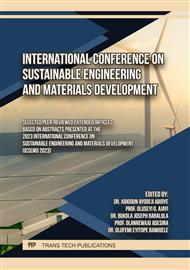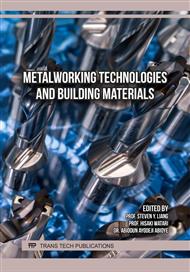p.3
p.9
p.15
p.27
p.35
p.43
p.51
p.59
Investigation into Stress Relaxation and Creep Rate of C47200 Copper Alloy
Abstract:
Copper alloys have high thermal conductivity, relatively high mechanical strength, and toughness over a wide range of temperature; hence they are highly sorted for complex structural applications that required extreme heat flux under load. Creep of materials is classically associated with time-dependent plasticity under a constant stress/load at an elevated temperature, often greater than the absolute melting temperature. This research is aimed to study the evaluation of stress and creep rate in copper, identifying the mechanisms at which copper can easily be exposed to stress and creep deformations in structures. A 12 mm diameter copper rod with the composition of 52.05 % CuO and 30.26 % SnO2 was procured locally. Samples from the procured rod were heat treated to 650°C for 30 minutes and cooled in the still air as well as inside the furnace. Creep test was carried out at 760uC with a constant load corresponding to an initial stress (between 1.5 MPa and 350 MPa) and stress relation was carried out on a 98 kN capacity stress relaxation frame (from 350 MPa to 300 MPa). Rockwell hardness test and metallographic analysis (at 200 mm) were also conducted on the heat treated and unheated control samples. It was established that heat treatment reduced the hardness property of stress relaxed copper, accelerated the stress relaxation process up to 60 %, speed up both primary creep rate and the tertiary creep rate as well altered the linear creep pattern and behaviour.
Info:
Periodical:
Pages:
15-25
Citation:
Online since:
March 2024
Keywords:
Price:
Сopyright:
© 2024 Trans Tech Publications Ltd. All Rights Reserved
Share:
Citation:



